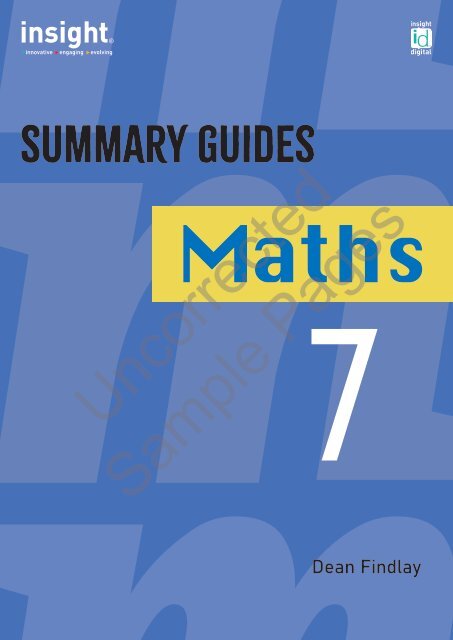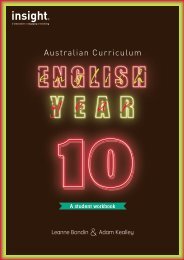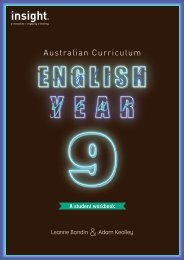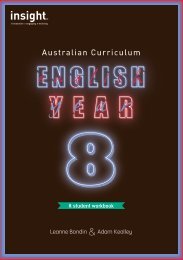Summary Guides - Maths 7 - Sample Pages
You also want an ePaper? Increase the reach of your titles
YUMPU automatically turns print PDFs into web optimized ePapers that Google loves.
<strong>Summary</strong> guides<br />
<strong>Maths</strong><br />
Uncorrected<br />
7<br />
<strong>Sample</strong> <strong>Pages</strong><br />
Dean Findlay
<strong>Summary</strong> <strong>Guides</strong><br />
<strong>Maths</strong> 7<br />
Dean Findlay<br />
Uncorrected<br />
<strong>Sample</strong> <strong>Pages</strong>
Table of Contents<br />
Introduction<br />
1. Number<br />
1.1 Place value<br />
1.2 Number symbols<br />
1.3 Addition and subtraction of whole numbers<br />
1.4 Multiplication of whole numbers<br />
1.5 Division of whole numbers<br />
1.6 Order of operations<br />
1.7 Estimation<br />
2. Fractions<br />
Answers<br />
2.1 Types of fractions<br />
2.2 Equivalent fractions<br />
2.3 Simplifying fractions<br />
2.4 Addition and subtraction of fractions<br />
2.5 Multiplication of fractions<br />
2.6 Division of fractions<br />
3. Decimals<br />
Answers<br />
Uncorrected<br />
3.1 Place value of decimals<br />
3.2 Comparing decimals<br />
3.3 Rounding decimals<br />
<strong>Sample</strong> <strong>Pages</strong><br />
3.4 Addition and subtraction of decimals<br />
3.5 Multiplying decimals by multiples of ten<br />
3.6 Multiplying decimals by decimals<br />
3.7 Division with decimals<br />
3.8 Decimals and fractions<br />
Answers<br />
Copyright © Insight Publicaons <strong>Summary</strong> <strong>Guides</strong> – <strong>Maths</strong> 7
4. Percentages, money, and time<br />
4.1 Decimals and percentages<br />
4.2 Percentage of an amount<br />
4.3 Fractions, decimals, and percentages<br />
4.4 Financial mathematics<br />
4.5 Time<br />
Answers<br />
5. Negative numbers<br />
5.1 Integers<br />
5.2 Comparing and ordering integers<br />
5.3 Addition and subtraction of integers<br />
5.4 Multiplication and division of integers<br />
5.5 Powers of integers<br />
5.6 Negative fractions<br />
5.7 Negative decimals<br />
Answers<br />
6. Factors, multiples, squares, and roots.<br />
6.1 Multiples<br />
6.2 Factors<br />
6.3 Divisibility<br />
6.4 Powers and roots<br />
6.5 Prime and composite numbers<br />
Answers<br />
7. Rates, ratios, and proportions<br />
7.1 Rates<br />
7.2 Ratios<br />
Uncorrected<br />
7.3 Proportions<br />
7.4 Combined applications<br />
Answers<br />
<strong>Sample</strong> <strong>Pages</strong><br />
Copyright © Insight Publicaons <strong>Summary</strong> <strong>Guides</strong> – <strong>Maths</strong> 7
8. Algebra<br />
8.1 Introduction to algebra<br />
8.2 Creating algebraic expressions<br />
8.3 Substitution<br />
8.4 Like terms<br />
8.5 Expanding<br />
8.6 Application of algebraic problems<br />
Answers<br />
9. Solving equations<br />
9.1 Introduction to equations<br />
9.2 Equivalent equations<br />
9.3 Solving equations algebraically<br />
9.4 Creating and solving equations<br />
9.5 Applications of equations<br />
Answers<br />
10. Patterns, rules, tables, and graphs<br />
10.1 Number patterns<br />
10.2 Spatial patterns<br />
10.3 Rules and tables<br />
10.4 Cartesian coordinates<br />
10.5 Transformations<br />
Answers<br />
11. Measurement<br />
11.1 Units of length<br />
11.2 Perimeter<br />
11.3 Area<br />
Uncorrected<br />
<strong>Sample</strong> <strong>Pages</strong><br />
11.4 Area of composite shapes<br />
11.5 Volume of rectangular prisms<br />
Answers<br />
Copyright © Insight Publicaons <strong>Summary</strong> <strong>Guides</strong> – <strong>Maths</strong> 7
12. Geometry<br />
12.1 Geometric notation<br />
12.2 Angles at a point<br />
12.3 Parallel lines<br />
12.4 Polygons<br />
12.5 Triangles<br />
12.6 Quadrilaterals<br />
12.7 Solids and nets<br />
12.8 Circle geometry<br />
Answers<br />
13. Statistics<br />
13.1 Numerical data<br />
13.2 Dot plots and column graphs<br />
13.3 Line graphs<br />
13.4 Stem and leaf plots<br />
13.5 Pie charts<br />
14. Probability<br />
Answers<br />
14.1 Introduction to probability<br />
14.2 Theoretical probability<br />
14.3 Experimental probability<br />
15. Algorithms<br />
Uncorrected<br />
Answers<br />
<strong>Sample</strong> <strong>Pages</strong><br />
Copyright © Insight Publicaons <strong>Summary</strong> <strong>Guides</strong> – <strong>Maths</strong> 7
Introduction<br />
The series, <strong>Summary</strong> <strong>Guides</strong> – <strong>Maths</strong>, has been written by practising teachers with<br />
years of classroom experience, who are passionate about creating user-friendly,<br />
accessible guides on mathematics.<br />
The explanations and exercises in these guides develop core numeracy skills for<br />
personal, work and civic life, and provide the base knowledge for the professional<br />
applications of maths as well as mathematical specialisations. <strong>Maths</strong> is part of your daily<br />
life no matter what you choose to do as an adult – it is important for thinking critically<br />
and making sense of the world.<br />
This book summarises key concepts in a clear and comprehensive way. It includes<br />
examples with worked solutions and step-by-step explanations, as well as exercises for<br />
you to complete. The best way to use this book is to make a habit of it – regularly<br />
working through the exercises and examples, and comparing your answers against those<br />
provided. Whether you commit to a daily, weekly or fortnightly routine, this consistent<br />
practice is the key to your success.<br />
The content of this book is based on years of experience in the classroom, making<br />
maths comprehensible and achievable for students. Through using this guide, you will be<br />
able to practise your skills and grow in confidence. We hope this resource will help you<br />
reap the rewards of maths.<br />
Dean Findlay and Insight Publications<br />
Uncorrected<br />
<strong>Sample</strong> <strong>Pages</strong><br />
Copyright © Insight Publicaons <strong>Summary</strong> <strong>Guides</strong> – <strong>Maths</strong> 7
Chapter 1 - Number<br />
Chapter 1 - Number<br />
Numbers are made up of the digits 0, 1, 2, 3, 4, 5, 6, 7, 8, 9.<br />
We use them every day for all types of mathematics.<br />
1.1 Place value<br />
The position of a digit in a number gives a different value to the digit.<br />
Here is an example of a place value chart for the number of people who attended the tennis<br />
on a day over the summer: 30 516<br />
Number 3 0 5 1 6<br />
Place Value<br />
Example<br />
Ten<br />
Thousands<br />
In the number 256, determine the place value of<br />
Thousands Hundreds Tens Ones<br />
a. the 2. b. the 5. c. the 6.<br />
Solution<br />
Working<br />
Explanation<br />
a. Hundreds The 2 in the whole number 256 is in the<br />
hundreds place.<br />
b. Tens The 5 in the whole number 256 is in the<br />
tens place.<br />
c. Ones The 6 in the whole number 256 is in the<br />
ones place.<br />
Exercise 1.1<br />
Uncorrected<br />
Note: it is common to also see the ‘ones’<br />
places called ‘units’<br />
<strong>Sample</strong> <strong>Pages</strong><br />
Determine the place value of each digit in brackets for the numbers listed.<br />
a. 23 045 (2) b. 562 021 (6) c. 803 096 (8) d. 451 382 (8)<br />
e. 12 538 (5) f. 837 036 (6) g. 34 789 (7) h. 89 123 (9)<br />
Copyright © Insight Publicaons <strong>Summary</strong> <strong>Guides</strong> – <strong>Maths</strong> 7
Chapter 1 – Number<br />
1.2 Number symbols<br />
There are different mathematical symbols that are used to compare numbers.<br />
Equal to Not equal to Greater than<br />
Greater than<br />
or equal to<br />
Less than<br />
Less than or<br />
equal to<br />
Example<br />
= ≠ > ≥ < ≤<br />
Complete the following number sentences by placing the correct symbol in each box.<br />
a. b. c. c.<br />
Solution<br />
Working<br />
Explanation<br />
a. Looking at the hundreds column, 300 is less<br />
than 500.<br />
b. Looking at the tens column, they are equal.<br />
Then look at the digits in the ones column, 9<br />
is greater than 6.<br />
c. Reading from left to right, the digits are<br />
equal until the tens column where 17 is less<br />
than 44.<br />
Exercise 1.2.1<br />
Uncorrected<br />
Complete the following number sentences by placing the correct symbol in each box.<br />
a. b. c. c.<br />
<strong>Sample</strong> <strong>Pages</strong><br />
d. e. e. f.<br />
Copyright © Insight Publicaons <strong>Summary</strong> <strong>Guides</strong> – <strong>Maths</strong> 7
Chapter 1 – Number<br />
Exercise 1.2.2<br />
Complete the following number sentences by placing the correct symbol in each box.<br />
a. b. c.<br />
d. e. f.<br />
1.3 Addition and subtraction of whole numbers<br />
Addition and subtraction of whole numbers requires a good understanding of place value<br />
from the previous section. Remember that sum means to add together, and difference means<br />
subtraction.<br />
There are many ways to add and subtract in mathematics. In this study guide we are going<br />
to explore two approaches: mental strategies and the addition and subtraction algorithms.<br />
Example<br />
Find the sum and difference of the following using mental strategies.<br />
a. 37 + 38 b. 54 + 22 c. 126 + 125<br />
d. 94 − 49 e. 88 − 43 f. 100 − 42<br />
Solution<br />
a. 37 + 38<br />
40 + 40 = 80<br />
80 − 5 = 75<br />
Working<br />
b. 50 + 4 and 20 + 2<br />
50 + 20 = 70<br />
4 + 2 = 6<br />
Explanation<br />
Round both up to 40 and calculate the sum.<br />
Uncorrected<br />
37(+3) and 38(+2)<br />
Then subtract the amount we rounded both<br />
up by.<br />
<strong>Sample</strong> <strong>Pages</strong><br />
Separate 54 and 22 into their place value.<br />
Add the tens and ones separately.<br />
54 + 22 = 76<br />
Combine for the final answer.<br />
Copyright © Insight Publicaons <strong>Summary</strong> <strong>Guides</strong> – <strong>Maths</strong> 7
Chapter 1 – Number<br />
c. 125 + 1 + 125<br />
Read 126 as 125 + 1<br />
125 × 2 + 1 = 251<br />
d. 95 − 50<br />
Double 125, then add 1.<br />
94 − 49 is difficult to think about. So, add 1<br />
to both numbers.<br />
= 45<br />
e. 80 + 8 and 40 + 3<br />
80 − 40 = 40<br />
8 − 3 = 5<br />
88 − 43 = 45<br />
f. 100 − 40 − 2<br />
= 58<br />
Example<br />
The difference will stay the same.<br />
Separate 88 and 43 into their place values.<br />
Subtract the tens and ones separately.<br />
Combine for the final answer.<br />
100 is easy to work with, so separate the 42<br />
into tens and ones.<br />
Subtract in parts.<br />
Find the sum of 28 and 34 using the addition algorithm.<br />
Solution<br />
Step 1.<br />
Step 2.<br />
Step 3.<br />
Uncorrected<br />
Working<br />
Explanation<br />
Set up the equation vertically with each digit<br />
lining up with the corresponding place value.<br />
Starting from the right (the ones), add the<br />
digits together.<br />
<strong>Sample</strong> <strong>Pages</strong><br />
The sum of the ones is larger than 9, so<br />
write down the value of the ones and carry<br />
the tens to step 3.<br />
Then add the digits in the tens column.<br />
Remember to add the one from the previous<br />
step.<br />
Copyright © Insight Publicaons <strong>Summary</strong> <strong>Guides</strong> – <strong>Maths</strong> 7
Chapter 1 – Number<br />
Example<br />
Find the difference of 174 and 28 using the subtraction algorithm.<br />
Solution<br />
Working<br />
Explanation<br />
Step 1.<br />
Step 2.<br />
Step 3.<br />
Exercise 1.3<br />
Set up the equation vertically with each digit<br />
lining up with the corresponding place value.<br />
Starting from the right (the ones), subtract<br />
the bottom digit from the top.<br />
Since 8 is more than 4, we must ‘borrow’<br />
from the tens column.<br />
We can then subtract 8 from 14.<br />
Then subtract the digits in the tens column,<br />
remembering the 7 tens are now 6 tens.<br />
Since there are no other hundreds, carry it<br />
down to the answer.<br />
Use an appropriate strategy to solve the following sum and difference problems.<br />
Uncorrected<br />
a. 95 + 12 b. 26 + 32 c. 145 + 143 d. 98 + 88<br />
e. 47 − 19 f. 76 − 13 g. 200 − 33 h. 457 − 112<br />
<strong>Sample</strong> <strong>Pages</strong><br />
Copyright © Insight Publicaons <strong>Summary</strong> <strong>Guides</strong> – <strong>Maths</strong> 7
Chapter 1 – Number<br />
Answers<br />
Exercise 1.1<br />
a. ten thousands b. ten thousands c. hundred thousands<br />
d. tens e. hundreds f. ones<br />
g. hundreds h. thousands<br />
Exercise 1.2.1<br />
a. 21 < 25 b. 234 > 226 c. 44 557 > 44 516<br />
d. 87 > 78 e. 190 381 > 190 234 f. 879 < 889<br />
Exercise 1.2.2<br />
a. b. c.<br />
d. e. f.<br />
Exercise 1.3<br />
a. 107 b. 58 c. 288 d. 186<br />
e. 28 f. 63 g. 167 h. 345<br />
Exercise 1.4<br />
a. 108 b. 255 c. 111111 d. 22222222<br />
e. 111111 f. 333333 g. 11111111 h. 55555555<br />
Exercise 1.5<br />
a. 12 b. 11 c. 90 d. 1728<br />
e. 54 f. 48 g. 26 h. 57<br />
Exercise 1.6<br />
Uncorrected<br />
<strong>Sample</strong> <strong>Pages</strong><br />
a. 38 b. 0 c. 19 d. 2<br />
e. 360 f. 58 g. 58 h. 29<br />
Copyright © Insight Publicaons <strong>Summary</strong> <strong>Guides</strong> – <strong>Maths</strong> 7












